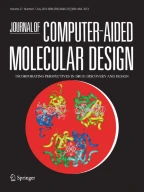Abstract
Here, we present a free web-accessible application, developed in the JAVA programming language for the calculation of vicinal coupling constant (3 J H,H) of organic molecules with the H–Csp3–Csp3–H fragment. This JAVA applet is oriented to assist chemists in structural and conformational analyses, allowing the user to calculate the averaged 3 J H,H values among conformers, according to its Boltzmann populations. Thus, the CAL3JHH program uses the Haasnoot–Leeuw–Altona equation, and, by reading the molecule geometry from a protein data bank (PDB) file format or from multiple pdb files, automatically detects all the coupled hydrogens, evaluating the data needed for this equation. Moreover, a “Graphical viewer” menu allows the display of the results on the 3D molecule structure, as well as the plotting of the Newman projection for the couplings.
Similar content being viewed by others
Notes
Richard R. Ernst in 1991 and Kurt Wüthrich in 2002 were awarded with the Nobel price by their contributions to the development of this technique. See http://www.nobel.se for more information.
The 3 J H,H is defined as the splitting between the 1H chemical shifts peaks, originated by the additional contributions of the magnetic fields of vicinal hydrogens to the magnetic field of each hydrogen.
See [5] and references therein.
PCMODEL. Available on Serena Software, PO Box, 3076, Bloomington, IN 47402-3076, U.S.A.
An illustrative case are the carbohydrates compounds which in liquid solution give mixture of open-chains and puckered-rings with different structures (e.g., the pyranose ring is a mixture of 38 different canonical ring forms, plus the OH hydroxyl groups which yield different rotamers). See for example: [11].
The program computes the couplings of each conformer and those values are affected by the ratio in a proportion multiplied by one. Being the final averaged value for each constant, the sum of all the particular values multiplied by its ratio.
Downloaded freeware from the JAVA web page, see reference [15].
The sign is not listed when the substituent is hydrogen since it does not participate, because the HLA equation accounts for the relative electronegativity (Δχatom = χatom − χH) of the substituents.
The ‘CONNECT’ records define the bonds not included in the standard residue connectivity table.
Rotation and zoom operations are available trough pressing the x, y, z and t letter in keyboard while dragging the mouse.
The energies are only needed to compute the averaged values among conformers. The input of the energy values for the different conformers can be set manually in this table—the E(kcal/mol) values in the corresponding column can be edited, or by default the energy values are read from each PDB file when a ‘REMARK’ record is found beginning with the text ‘ENERGY(KCAL/MOL)=value’, (where value means the energy data).
The CAL3JHH has no restrictions on the number of molecules (or the file size) that can handle, except for the local hardware limitations.
Although, the protein backbone has no H-Csp3-Csp3-H torsion angles, and the calculation of vicinal coupling constants are applicable only to the substituents, we include this example to illustrate the power of calculation of CAL3JHH program to automatically recognize such coupling constants for large PDB files.
This process, performed in a notebook with the Intel Core 2 Duo processor (1,5 GHz, 667 MHz, 2 MB), lasted six seconds.
References
Eberstadt M, Gemmecker G, Mierke DF, Kessler H (1995) Angew Chem Int Ed 34:1671
Karplus M (1959) J Chem Phys 30:11
Duus JØ, Gotfredsen CH, Bock K (2000) Chem Rev 100:4589
Altona C, Francke R, De Haan R, Ippel JH, Daalmans GJ, Hoekzema AJAW, Van Wijk J (1994) Magn Reson Chem 32:670
Hassnoot CAG , De Leeuw FAAM, Altona C (1980) Tetrahedron 36:2783
Huggins ML (1953) J Am Chem Soc 75:4123
Abraham RJ, Fisher J, Lofitus P (1997) Introduction to NMR spectroscopy. Wiley
(a) Osawa E, Jaime C, 3JHH Program, Department of Chemistry, Faculty of Science, Hokkaido University, Sapporo 060, Japan; (b) Keisuke I, Osawa E, 3JHH2 Program, Department of Chemistry, Faculty of Science, Hokkaido University, Sapporo 060, Japan; (c) Petillo PA, Osawa E, Jaime C, 3JHHPC Program, Department of Chemistry, University of New Hampshire, Durham, New Hampshire 03824 and Department of Chemistry, Faculty of Science, Hokkaido University, Sapporo 060, Japan
Cerda-García-Rojas CM, Zepeda LG, Joseph-Nathan PA (1990) Tetrahedron Comput Method 3:113
Balacco G (1996) J Chem Inf Comput Sci 36:885
Cramer CJ, Truhlar DG (1993) J Am Chem Soc 115:5745
Tinoco I, Jr., Saner K, Wang JC (1978) Physical chemistry: principles and applications in biological sciences. Prentice Hall, New Jersey
Melchor S, Dobado JA (2004) J Chem Inf Comput Sci 44:1639. CONTUB program: available on http://www.ugr.es/~gmdm/java/contub/contub.htm
Gaussian 98, revision A.7 (1998) Gaussian, Inc., Pittsburgh, PA
SDBS Database, National Institute of Advanced Industrial Science and Technology, Tsukuba, Ibaraki, Japan, http://www.aist.go.jp/RIODB/SDBS/menu-e.hmtl
Sulzenbacher G, Bignon C, Nishimura T, Tarling CA, Withers SG, Henrissat B, Bourne Y (2004) J Biol Chem 279:13119
Aguirre-Valderrama A, Dobado JA (2006) J Carbohydr Chem 25:557
Isac-García J, Calvo-Flores FG, Hernández-Mateo F, Santoyo-González F (1999) Chem Eur J 5:1512
Hughes NA, Munkombwe NM, Todhunter ND (1991) Carbohydr Res 216:119
Acknowledgements
We thank Dr. S. Melchor for its support on the 3D viewer algorithm. Junta de Andalucía is also acknowledged for their financial support (FQM-174). We also thank D. Nesbitt for reviewing the language of the English manuscript.
Author information
Authors and Affiliations
Corresponding author
Electronic supplementary material
This file is unfortunately not in the Publisher's archive anymore: All the examples discussed are included: pdb files and results of vicinal coupling constants calculation (jhh extension) (rar 455 KB)
Rights and permissions
About this article
Cite this article
Aguirre-Valderrama, A., Dobado, J.A. CAL3JHH: a Java program to calculate the vicinal coupling constants (3JH,H) of organic molecules. J Comput Aided Mol Des 22, 907–914 (2008). https://doi.org/10.1007/s10822-008-9226-3
Received:
Accepted:
Published:
Issue Date:
DOI: https://doi.org/10.1007/s10822-008-9226-3
